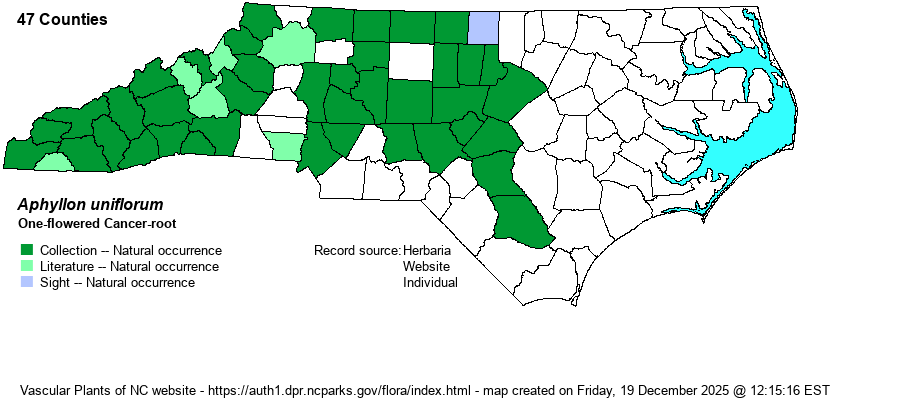| Author | (L.) Torrey & A. Gray | |
| Distribution | Present over all of the Mountains and most of the Piedmont, though seemingly absent from the northeastern corner. In the Coastal Plain known only from slopes along the Cape Fear River into Bladen County.
This is a very widespread species in North America, from Canada south to central FL and CA; scarce on the Coastal Plains. | |
| Abundance | Fairly common in the central and southern Mountains; generally infrequent in the northern Mountains and the Piedmont, except very rare in the northeastern corner of the latter province. Seems to have declined in recent years, as Cronquist and Oosting (1959) considered it as "Frequent" in the Piedmont. Very rare in the southwestern Coastal Plain, limited to the Cape Fear River slopes. | |
| Habitat | This is a species of rich wooded slopes and rocky slopes, but it is also found on wooded stream banks. It favors Mesic Mixed Hardwood Forests and Rich Cove Forests, but it is also found in Basic Mesic Forest as well. | |
| Phenology | Blooms in April and May, and fruits shortly after flowering. | |
| Identification | This is a small and very easily overlooked species, and as it is a spring ephemeral species -- disappearing underground after fruiting by late May -- finding it can be difficult even though it isn't a rare species in the state. It is a root parasite with no chlorophyll, and thus is essentially white or cream-colored throughout, growing only to about 4-5 inches tall. A given plant can send up a few stalks, usually in small groups of plants, with the leaves being brown scales at the base of the stem. At the tip of the stem is the single white to pale lavender flower, with yellow in the throat; it is curved to face horizontally, with 5 spreading petals and looking a bit like a white violet, about 3/4-inch across. Though the plants are small, thankfully for the observer the entire plant is whitish, quite like an Indian-pipe (Monotropa uniflora) at first glance. Thus, on a spring walk along the base of a rich slope, or along a wooded stream bank, keep your eyes open for these "white pipes". Though there is no assurance that the species has declined in the past 60 years, it can hardly be called a "frequent" species nowadays in much or most of the Piedmont, and it is always a notable day when you stumble onto the species. | |
| Taxonomic Comments | Until very recently, it had always been named as Orobanche uniflora.
| |
| Other Common Name(s) | Cancer-root, One-flowered Broomrape, Ghostpipe | |
| State Rank | S3 [S4] | |
| Global Rank | G5 | |
| State Status | | |
| US Status | | |
| USACE-agcp | | |
| USACE-emp | | |

